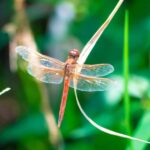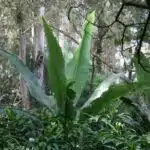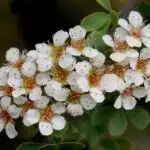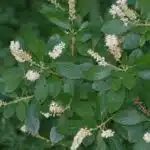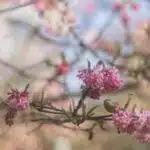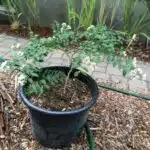Banana shrubs, also known as Michelia figo, are popular ornamental plants due to their attractive foliage and fragrant flowers. Native to China, Taiwan, and Vietnam, these shrubs have become a favorite among horticulturists for their hardiness and versatility in various growing conditions. As a banana shrub horticulturist, I am excited to share with you the growing profile of this plant that will enable you to cultivate it successfully.
The banana shrub is an evergreen plant that can grow up to 20 feet tall and spread up to 15 feet wide. It has glossy, dark green leaves that are 3-6 inches long and produce small yellowish-green flowers with a strong banana-like fragrance from early spring through summer. The bushy growth habit of the banana shrub makes it an ideal option for use as a hedge or screen plant. Its adaptability to different soil types and climates makes it an excellent addition to any garden or landscape design. In this article, we will explore the necessary steps required for successful cultivation of the banana shrub while highlighting its numerous benefits for both garden enthusiasts and professional landscapers alike.
Background And History Of Michelia Figo
Although Michelia Figo, commonly known as banana shrub, is native to China, it has been widely cultivated in various Asian countries for centuries. Its cultural significance can be traced back to ancient times when it was used for traditional medicine by Chinese herbalists. The plant’s fruits were believed to have healing properties and were used to treat a variety of ailments such as fever, cough, and digestive disorders.
In addition to its medicinal uses, the banana shrub also holds cultural significance in many Asian countries. In Japan, the flowers are often used in tea ceremonies due to their sweet fragrance. In China and Vietnam, the flowers are used in perfumes and cosmetics. Furthermore, the plant’s wood is highly valued for carving and furniture making.
As horticulturists of this species, we are fascinated by the rich history and cultural significance of the banana shrub. Through our research and experience with this plant, we have come to appreciate its unique characteristics and versatility. In the following section, we will delve into the specific traits that make this plant so special.
Characteristics And Appearance Of The Banana Shrub
The Michelia Figo, commonly known as the Banana Shrub, has a rich background and history dating back to ancient China. This plant is famous for its use in traditional Chinese medicine and has been used to treat various ailments for centuries. The banana shrub’s popularity spread throughout Asia over time, with many people using it for ornamental purposes as well.
The banana shrub is a beautiful plant that boasts shiny, dark green leaves and fragrant yellow flowers that bloom during spring and summer. Its flowers exude a sweet banana scent that can fill up an entire garden. The plant can grow up to 15 feet tall and 10 feet wide, making it perfect for use as a privacy screen or hedge.
Aside from its beauty and aroma, the banana shrub also has practical uses in cooking and medicinal properties. Its leaves have been used to add flavor to dishes such as rice cakes, while its bark and roots contain alkaloids that are useful in treating fevers, coughs, and other respiratory problems. Its essential oil is also used in aromatherapy due to its calming effect on the mind and body.
- The banana shrub is easy to care for and requires minimal maintenance.
- It thrives in warm climates but can also grow well in milder areas.
- When planting, ensure that there is enough space between each plant to allow for proper growth.
- Prune regularly during late winter or early spring to maintain shape.
- Fertilize with a balanced fertilizer every two weeks during the growing season.
As a horticulturist specializing in banana shrubs, I highly recommend this plant for anyone looking to add beauty and fragrance to their garden while enjoying its practical uses at the same time. In the next section, we will discuss soil and water requirements necessary for optimal growth of this magnificent plant.
Soil And Water Requirements For Optimal Growth
As the old saying goes, “you reap what you sow.” This is especially true when it comes to growing banana shrubs. In order to achieve optimal growth, it is important to pay close attention to the soil and water requirements of these plants.
When it comes to soil, banana shrubs prefer a well-draining medium that is rich in organic matter. Adding compost to the soil can help improve drainage while also enhancing nutrient availability. Composting benefits not only the plant but also the surrounding environment by reducing waste and promoting sustainability.
In terms of water requirements, banana shrubs prefer a consistent moisture level. However, overwatering can lead to root rot and other issues, so it is important to allow the soil to dry out slightly between waterings. Fertilizer options should also be considered carefully, as too much nitrogen can result in lush foliage but fewer flowers. By providing appropriate soil and water conditions, banana shrubs can thrive and provide years of enjoyment for gardeners and nature enthusiasts alike.
To continue on this path of successful growth, it is important to consider the light and temperature preferences of these plants. Banana shrubs generally prefer partial shade or filtered sunlight with temperatures ranging between 60-80 degrees Fahrenheit. Understanding these preferences will help ensure continued health and vitality for your banana shrub.
Light And Temperature Preferences
The banana shrub is a tropical plant that prefers to grow in full sun, but it can also adapt to partial shade. In general, the banana shrub prefers warm and humid climates, with temperatures ranging from 60°F to 80°F. In indoor cultivation, it’s important to place the banana shrub near a window that receives plenty of sunlight or use artificial lighting if natural light is unavailable.
Climate adaptation is an important consideration when growing banana shrubs in areas with colder temperatures. While they can withstand brief cold snaps and even light frosts, extended periods of freezing weather can cause significant damage or death to the plant. Therefore, gardeners living in colder regions should consider planting the banana shrub in containers that can be moved indoors during winter months or cover them with protective material.
To ensure optimal growth and health of your banana shrub, it’s crucial to provide it with adequate light and temperature conditions. By following these three tips, you can help your banana shrub thrive:
- Place your plant near a south-facing window or under grow lights to expose it to plenty of sunlight.
- Keep your plant in a room where temperatures stay between 60°F and 80°F.
- Consider planting your banana shrub in containers that can be moved indoors during winter months if you live in a region with colder temperatures.
As a horticulturist who specializes in growing banana shrubs, I recommend paying attention to climate adaptation and providing adequate light and temperature conditions for optimal growth. In the next section, we will discuss pruning and maintenance tips for keeping your banana shrub healthy and vibrant throughout its lifespan.
Pruning And Maintenance Tips
Banana shrubs require regular pruning for optimal growth and maintenance. Pruning is necessary to encourage new growth, prevent disease and pests, and promote a fuller, healthier plant. Tools needed for pruning include pruning shears, loppers, and a saw. It is important to use sharp tools to avoid damaging the plant.
Pruning frequency depends on the age and size of the banana shrub. Younger plants may require more frequent pruning to help shape them into the desired form, while mature plants typically need less frequent pruning. The best time to prune a banana shrub is in late winter or early spring before new growth begins. This allows for a clean cut without harming any new growth.
Regular maintenance of a banana shrub can also involve removing dead or diseased branches throughout the year as they are noticed. This will not only help the overall health of the plant but also improve its appearance. In addition to pruning, it is important to fertilize regularly with a balanced fertilizer and water deeply during dry periods.
As with any plant, proper care and maintenance are essential for healthy growth and reproduction. In the next section, we will discuss propagation and reproduction techniques that can be used to expand your collection of banana shrubs or share them with others.
Propagation And Reproduction Techniques
Propagation of banana shrub plants can be achieved through the use of cuttings, layering, grafting, and division. Reproduction of banana shrub plants is achieved through pollination, seed germination, air layers, cross-pollination, budding, and seed saving. Cloning of banana shrub plants is possible through the use of spores, rhizomes, and tissue culture. To ensure successful propagation and reproduction of banana shrub plants, careful consideration must be given to the environmental conditions and pollinator availability.
Propagation
Propagating banana shrubs is a great way to expand your garden and enjoy the beautiful blooms of this plant. The best time to propagate banana shrubs is in the spring or early summer when the plant is actively growing. There are two primary methods for propagating banana shrubs: rooting hormone and division techniques.
Rooting hormone is a popular method used for propagating banana shrubs. To begin, take a cutting from the parent plant that has at least two sets of leaves. Dip the cut end of the stem into rooting hormone powder and then plant it in well-draining soil. Keep the soil moist and place the cutting in an area with indirect sunlight until new growth appears.
Division techniques involve separating a portion of the parent plant to create a new one. This method is best used on more mature plants. Begin by carefully removing the parent plant from its pot or ground location. Use a sharp knife or pruning shears to divide the root ball into smaller sections, making sure that each section has roots and stems attached. Plant each divided section in well-draining soil, water thoroughly, and place in an area with indirect sunlight.
In conclusion, propagating banana shrubs can be done easily using either rooting hormone or division techniques. Each method has its advantages, so it’s important to choose which one works best for you based on your experience level and specific needs. With proper care and attention, your newly propagated banana shrub will thrive and provide beauty to any garden space!
Reproduction
As a banana shrub horticulturist, it’s important to understand the different methods of plant reproduction. Banana shrubs can reproduce through both sexual and asexual means. Sexual reproduction occurs through pollination methods such as wind or insect pollination, resulting in the production of seeds. Seed germination is then initiated under favorable conditions, leading to the growth of a new banana shrub. Asexual reproduction, on the other hand, involves using vegetative propagation techniques such as rooting hormone or division.
When it comes to sexual reproduction in banana shrubs, pollination occurs when pollen from the male reproductive parts of one plant fertilizes the female reproductive parts of another plant. Wind is often the primary agent for pollination in banana shrubs, but insects such as bees can also play a role. The resulting seeds can be used for propagation purposes or left to grow naturally.
In contrast to sexual reproduction, asexual propagation techniques such as rooting hormone and division allow for an exact replica of the parent plant to be produced without relying on seed germination. This method is often preferred by horticulturists since it guarantees that desirable traits will be passed down to the new plants. By utilizing these techniques, gardeners can quickly and easily expand their collection of beautiful and healthy banana shrubs without waiting for natural seed germination to occur.
Common Pests And Diseases To Watch Out For
To ensure the health and vitality of your banana shrub, it is important to be aware of common pests and diseases that may threaten its well-being. Prevention measures are key in avoiding infestations and infections. Regularly inspecting your plant for any signs of damage or discoloration can help catch issues early on. Additionally, ensuring proper soil drainage and adequate sunlight can also contribute to a healthy plant.
Despite preventative measures, it is possible for pests and diseases to still affect your banana shrub. One common pest to watch out for is the banana shrub borer, which can cause severe damage to the plant’s trunk and branches. Treatment options include insecticides or physically removing the affected areas of the plant. Another potential threat is fungal infections such as leaf spot or powdery mildew, which can be treated with fungicides or through pruning infected areas.
As a banana shrub horticulturist, my top recommendation for avoiding pest and disease problems is companion planting. By strategically planting other species that naturally repel pests or attract beneficial insects, you can create a more diverse and resilient ecosystem around your banana shrub. Some examples of companion plants include marigolds to deter nematodes, lavender to attract pollinators like bees, and garlic to fend off aphids. By incorporating these companions into your garden design, you not only promote the health of your banana shrub but also support a thriving overall garden ecosystem.
Moving on from our discussion on common pests and diseases, let us now explore some companion planting suggestions to further enhance the growth and well-being of your beloved banana shrub.
Companion Planting Suggestions
Companion planting provides multiple benefits including increased pest control, improved soil fertility, and increased crop yields. The use of pest deterrent plants, such as marigolds, can help to reduce the presence of damaging pests that can damage banana shrubs. Incorporating soil fertility enhancers, such as nitrogen fixing legumes, can help improve the soil fertility of the area which can improve the health of the banana shrub. The use of companion planting techniques is an effective way to achieve pest control, improved soil fertility, and increased crop yields. Additionally, companion planting can also help to improve the biodiversity of the area and provide habitat for beneficial insects. Therefore, companion planting is an effective strategy for banana shrub horticulturists to use to improve the health and productivity of their crop.
Companion Planting Benefits
As a banana shrub horticulturist, I have found that intercropping options can be highly beneficial for the growth and health of banana shrubs. Companion planting is an effective way to maximize garden space and create a diverse ecosystem that promotes plant growth. By pairing banana shrubs with other plants that have complementary needs, you can provide them with the necessary nutrients while also preventing pests.
One of the most effective companion plants for banana shrubs is garlic. Garlic has natural pest prevention strategies that can help keep away harmful insects from your banana shrubs. Its pungent aroma repels aphids, mites, and other pests that could damage your plants. Additionally, garlic’s root system helps to aerate soil and add organic matter which creates a healthy growing environment for your banana shrub.
Another great companion plant option is marigolds. Marigolds not only add color to your garden but also deter nematodes from attacking the roots of your banana shrub. These flowers release chemicals into the soil that repel these harmful pests without harming beneficial insects like bees or butterflies. Intercropping marigolds with banana shrubs can also help attract pollinators which will increase yields and promote overall plant health.
In conclusion, intercropping options like garlic and marigolds are excellent companion planting suggestions for those looking to grow healthy and vibrant banana shrubs. Not only do they provide natural pest prevention strategies but they also promote soil health and attract beneficial insects which promote overall garden productivity. By incorporating these companion plants into your gardening routine, you’ll be able to create a thriving ecosystem that serves both you and nature alike.
Pest Deterrent Plants
As a banana shrub horticulturist, I have always been interested in finding natural repellents that can protect plants from pests. One effective way to achieve this is through companion planting. Companion planting involves growing two or more types of plants together for mutual benefit. By planting certain species of plants alongside banana shrubs, we can create a natural barrier against pests without resorting to harmful chemicals.
One of the most popular pest deterrent plants for companion planting is mint. Mint has a strong scent that repels many insects, including aphids and ants. Planting mint around your banana shrubs can help keep these pests at bay while also adding a refreshing aroma to your garden. However, it’s important to note that mint can be quite invasive, so it’s best to plant it in pots or areas where it won’t spread uncontrollably.
Another effective pest deterrent plant is chives. Chives contain sulfur compounds that naturally repel many common garden pests, such as slugs and snails. Planting chives near your banana shrubs can help protect them from these slimy invaders while also providing you with a delicious herb for cooking. Additionally, chives attract beneficial insects like bees and butterflies which pollinate your garden and promote overall plant health.
In conclusion, incorporating natural pest deterrent plants into companion planting schemes can provide numerous benefits for our gardens, including healthier banana shrubs and reduced reliance on harmful pesticides. Mint and chives are just two examples of the many options available for those looking to create an eco-friendly garden space that supports both plant growth and environmental sustainability. So why not give companion planting a try today? Your banana shrubs (and the planet) will thank you!
Soil Fertility Enhancers
As a banana shrub horticulturist, I am always looking for ways to improve the health and productivity of my plants. One effective method is through companion planting, which involves growing different types of plants together for mutual benefit. In addition to pest deterrents such as mint and chives, there are also soil fertility enhancers that can be incorporated into companion planting schemes.
Composting is one organic amendment that can greatly benefit soil fertility. Composting involves breaking down organic matter such as food scraps, yard waste, and leaves into nutrient-rich soil amendments. Adding compost to the soil around banana shrubs can improve soil structure, retain moisture, increase nutrient availability, and promote healthy root growth. Additionally, composting reduces waste and supports environmental sustainability.
In addition to composting benefits, other organic amendments such as bone meal, seaweed meal, and worm castings can also enhance soil fertility. Bone meal is high in phosphorus which promotes flower and fruit production in banana shrubs. Seaweed meal contains trace minerals that are essential for plant growth and development. Worm castings are rich in nitrogen which supports leafy green growth in banana shrubs. Incorporating these organic amendments into companion planting schemes can help create a thriving ecosystem that benefits not only the banana shrubs but also the surrounding environment.
Creative Landscape Design Ideas For Banana Shrubs
Companion planting can be an effective way to maximize the growth of your banana shrubs. One suggestion is to plant them alongside other evergreens like camellias and hollies, as they complement each other’s foliage and provide a year-round display of greenery. In addition, banana shrubs can also benefit from the presence of flowering plants like azaleas and hydrangeas, which attract pollinators that help fertilize the shrub’s blooms.
When it comes to landscaping ideas for banana shrubs, one option is to use them as a hedge. Their dense foliage makes them ideal for creating a natural barrier that adds privacy and security to your property. Plus, their yellow flowers emit a sweet fragrance that can enhance the ambiance of your outdoor space. Another creative idea is to use banana shrubs as container plants, which allows you to move them around and create versatile arrangements both indoors and outside.
Whether you’re planting banana shrubs for the first time or have been growing them for years, there are likely some questions you have about their cultivation. From pruning techniques to pest control strategies, there are various factors that can affect the health and vitality of your plants. In the next section, we’ll explore some frequently asked questions about banana shrub care so you can get the most out of your garden.
Frequently Asked Questions About Banana Shrub Cultivation
As a banana shrub horticulturist, I am often asked about the best practices for cultivating this beautiful plant. One common question is whether or not banana shrubs can be grown in containers. The answer is yes! Container gardening is an excellent option for those who have limited outdoor space or want to keep their plants mobile. When growing a banana shrub in a container, it’s important to choose a pot that is large enough to accommodate the plant’s root system and provide adequate drainage.
Another frequently asked question about banana shrub cultivation is regarding its biodiversity benefits. Banana shrubs are known to attract a variety of pollinators, including bees and butterflies. This makes them an excellent addition to any garden as they help support local ecosystems and promote biodiversity. In addition, their fragrant blooms make them an ideal choice for those who want to add a touch of beauty and aroma to their outdoor space.
For those interested in growing banana shrubs, it’s important to note that they require well-draining soil and partial shade. Additionally, regular pruning is necessary to maintain its shape and promote healthy growth. By following these basic care guidelines, you can ensure your banana shrub thrives and contributes to the biodiversity of your local environment.
Overall, banana shrubs are versatile and attractive plants with many benefits for both gardeners and the environment. Whether grown in containers or planted directly in the ground, they’re sure to bring joy and beauty to any outdoor space.
Conclusion
Michelia Figo, commonly known as the Banana Shrub, has a rich history and unique characteristics that make it an attractive addition to any landscape. This evergreen shrub, native to China and Korea, was introduced to the United States in the 1700s and has since become a popular ornamental plant due to its fragrant blooms and glossy foliage.
The Banana Shrub can grow up to 20 feet tall and produces creamy-yellow flowers with a strong banana fragrance from late spring to summer. It prefers well-draining soil that is slightly acidic, and requires regular watering to maintain optimal growth. This shrub thrives in partial shade and temperatures between 60-80°F.
One example of successful banana shrub cultivation is at the Atlanta Botanical Garden where they have incorporated this plant into their woodland garden design. The lush foliage and fragrant blooms create an inviting atmosphere for visitors while also providing habitat for local wildlife.
As a horticulturist specializing in Banana Shrubs, I highly recommend this plant for anyone looking to add beauty and fragrance to their landscape. With proper care and maintenance, this shrub can thrive for years to come. So why not consider incorporating a Banana Shrub into your next landscaping project? Your senses (and local wildlife) will thank you!
Image Credits
- “banana” by keepon (featured)






